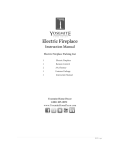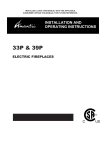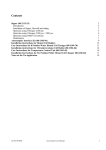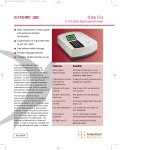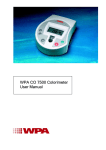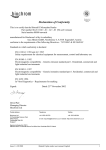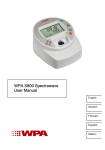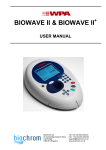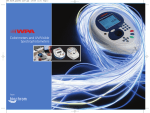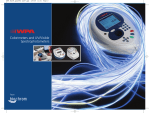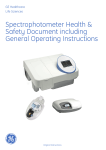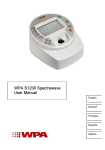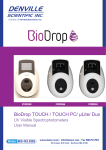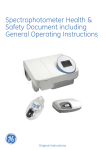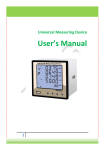Download Ultrospec 2100pro User Manual
Transcript
Ultrospec 2100 pro User Manual English Deutsch Français Español Italiano Biochrom Ltd Certificate No. 890333 Declaration of Conformity This is to certify that the Ultrospec 2100 pro UV/Visible Spectrophotometer Part number 80-2112-21 / 22 / 27 / 28 Serial number 79000 onwards manufactured by Biochrom Ltd. conforms to the requirements of the following Directives-: 73/23/EEC & 89/336/EEC Standards to which conformity is declared EN 61 010-1: 2001 Safety requirements for electrical equipment for measurement, control and laboratory use. EN 61326: 1998 Electrical equipment for measurement, control and laboratory use – EMC requirements Dated: 23nd October 2002 Signed: David Parr Managing Director Biochrom Ltd Postal address Telephone Telefax Biochrom Ltd 22 Cambridge Science Park Milton Road Cambridge CB4 0FJ England +44 1223 423723 +44 1223 420164 e mail: [email protected] website: http://www.biochrom.co.uk Registered in England No: 974213 Registered Office: 22 Cambridge Science Park, Milton Road, Cambridge CB4 4FJ, England. CONTENTS UNPACKING, POSITIONING AND INSTALLATION Essential Safety Notes 2 3 OPERATION Introduction Keypad and display Basic Modes (1) Absorbance (1.1) % Transmission (1.2) Factor Concentration (1.3) Applications (2) Wavescan (2.1) Simple Kinetics (2.2) Reaction Rate (2.3) Standard Curve (2.4) Multiwave and Equation Entry (2.5) Nucleic Modes (3) Methods A (4), B (5) and C (6) System Utilities Output to Printer Seiko DPU-414 (1) Epson FX-80+ / Epson 9 pin (2) Text printer (no graphics) (3) HP PCL 3 (4) Epson 24 pin (ESC P) (5) Download to Spreadsheet Messages 4 4 5 6 6 6 6 7 7 8 9 10 11 12 13 14 16 16 16 16 16 16 17 17 ACCESSORIES Multiple Cell Holder Accessories Single Cell Holder Accessories Other Accessories, consumables etc SWIFT II Applications Software 18 18 19 20 21 MAINTENANCE After Sales Support Fuse Replacement Cleaning and General Care 22 22 22 23 APPENDIX Text entry Good Laboratory Practice Least squares regression analysis and linearity 24 24 25 26 SPECIFICATION AND WARRANTY 27 ___________________________________________________________________ Issue 06 - 12/2003 Ultrospec 2100 pro, English 1 Unpacking, Positioning and Installation • • • • • • • Inspect the instrument for any signs of damage caused in transit. If any damage is discovered, inform your supplier immediately. Ensure your proposed installation site conforms to the environmental conditions for safe operation: Indoor use only Temperature 10°C to 40°C Maximum relative humidity of 80 % up to 31°C decreasing linearly to 50 % at 40°C The instrument must be placed on a hard flat surface, for example a laboratory bench or table, which can take its weight (13 kg) such that air is allowed to circulate freely around the instrument. Ensure that the cooling fan inlets and outlets are not obstructed; position at least 2 inches from the wall. This equipment must be connected to the power supply with the power cord supplied and must be earthed (grounded). It can be used on 90 - 240V supplies. Switch on the instrument and check that the display works (see Operation). To enter laboratory name, operator name, instrument asset number details, and current date/time, refer to System Utilities. If this equipment is used in a manner not specified or in environmental conditions not appropriate for safe operation, the protection provided by the equipment may be impaired and instrument warranty withdrawn. ___________________________________________________________________ 2 Ultrospec 2100 pro, English Issue 06 - 12/2003 Essential Safety Notes There are a number of warning labels and symbols on your instrument. These are there to inform you where potential danger exists or particular caution is required. Before commencing installation, please take time to familiarise yourself with these symbols and their meaning. Caution (refer to accompanying documents). Background colour is yellow, symbol and outline are black. WARNING UV RADIATION HOT WARNING UV RADIATION IS HARMFUL TO YOUR EYES If power is restored with this cover removed, eye protection must be worn Accessories • • • Care should be taken when handling all heated accessories. Ensure that the cell compartment lid is closed when operating cell changers and the sipper. It is essential that the baseplate plug supplied with single cell accessories is fitted to optimise air flow and to prevent light ingress. ___________________________________________________________________ Issue 06 - 12/2003 Ultrospec 2100 pro, English 3 OPERATION Introduction Your UV/Visible spectrophotometer is a stand alone, simple-to-use instrument with a high-resolution liquid crystal display (LCD), and a comprehensive range of spectrophotometry measurements can be undertaken. It works on the basis of light from the xenon lamp being directed by a fixed mirror through the monochromator inlet slit. This passes through one of several (dependent on wavelength selected) filters mounted on filter quadrant: the filtered light is then directed onto the holographic grating which produces light of the selected wavelength. The light then leaves the monochromator via the exit slit, and mirrors focus and direct the light into the sample compartment. This passes through your cell, containing the sample of interest, and then a defocusing lens to a solid state detector unit. The resulting signal is then filtered and displayed. Your spectrophotometer has the following capabilities: • • • • • • • Basic Modes for -Absorbance -% Transmission -Factor Concentration Application Modes for - Wavescan (Wavelength Scanning ) - Simple Kinetics - Reaction Rate - Standard Curve - Multiple Wavelength (Multi Wavelength Equation Entry) Stored parameters for Nucleic Acid quantification and purity checking - DNA - RNA - Oligonucleotide 18 user defined methods, in 3 groups of 6 - Methods A, B, C Print results from the instrument display in graphical format Download of results directly to Excel for manipulation and archiving, via a serial interface lead to a PC Self test diagnostics for GLP purposes A range of accessories further enhances the capability of the instrument. The home page provides access to user modes, system utilities and accessory identification and set-up. ___________________________________________________________________ 4 Ultrospec 2100 pro, English Issue 06 - 12/2003 Keypad and display Press the soft key on the keypad directly below the corresponding option on the display (F1, F2 and F3) to select that option. For example, on the home page (above): • press F1 to take you to System Utilities • press F2 to identify the type of cell changer / holder that has been fitted • press F3 to toggle the display back-light on/off (display contrast can be changed within System (F1) Press: • ← to print result if auto-print is off, or to re-print result if auto-print is on to back space in order to correct text and characters in appropriate boxes to start making measurements and print results (green run key) to stop making measurements or entering parameters and return to the home page; use as an “escape mechanism” (red stop key) Press the corresponding number on the keypad to enter the user mode choices; for example 1 followed by 1 is Absorbance mode, whereas 2 followed by 4 is Standard Curve Mode. ___________________________________________________________________ Issue 06 - 12/2003 Ultrospec 2100 pro, English 5 Basic Modes (1) Absorbance (1.1) Absorbance mode measures the amount of light that has passed through a sample relative to a blank (this can be air). The procedure is as follows: • Enter appropriate wavelength and press OK (F3) • Insert reference and press green run key. The cell changer, if fitted, automatically moves to position 2 and displays the result for the reference measurement (0.000) • Xenon lamp based instruments are “press to read”, whereas deuterium / tungsten lamp instruments measure continuously. Thus to monitor sample stabilisation, the simple kinetics mode must be used • This reference value is used for subsequent samples until changed • • Insert samples as required and press (repeat as necessary) To go back and change the wavelength press Method (F1) % Transmission (1.2) Transmission mode measures the amount of light that has passed through a sample relative to a blank (this can be air), but displays the result as a percentage. The procedure is as follows: • Enter appropriate wavelength and press OK (F3) • Insert reference and press green run key • This reference value is used for subsequent samples until changed • • Insert samples as required and press (repeat as necessary) To go back and change the wavelength press Method (F1) Factor Concentration (1.3) Concentration mode is used when a conversion factor is known, and converts the absorbance measurement for a sample at a specific wavelength into a concentration, by a simple multiplication of absorbance x factor. The procedure is as follows: • Enter appropriate wavelength and press OK (F3) • Enter known factor (range 0.01-9999) and press OK (F3) • To enter a negative factor press – (F1); the reference should have a higher absorbance than the samples • Insert reference and press green run key • This reference value is used for subsequent samples until changed • • Insert samples as required and press (repeat as necessary) To go back and change the wavelength or factor press Method (F1) ___________________________________________________________________ 6 Ultrospec 2100 pro, English Issue 06 - 12/2003 Applications (2) Wavescan (2.1) An absorption spectrum can be obtained from your instrument; this enables simple identification of peak height and position. A reference scan has to be obtained first. The procedure is as follows: • • • Enter start wavelength (range 190-890nm) and press OK (F3) Enter end wavelength (range 200-900nm) and press OK (F3) Select scan speed as appropriate; slow (1), medium (2), fast (3) or survey (4). The scan speed depends on the wavelength range due to the wide range in baseline energy and this in turn affects data interval, so the figures are nominal. • Select if the peak check table is required; if selected, a table of wavelengths and absorbance maxima for up to 20 peaks can be printed out Nominal scan speed, nm/min Slow 250 Medium 750 Fast 1800 Survey 3000 • Insert reference and press green run key to obtain reference spectrum • This reference spectrum is used for subsequent samples until changed • • • Insert samples as required and press (repeat as necessary) Press Data (F3) to access data points; these can be viewed by moving the cursor (F2 and F1) a peak is indicated by a flag symbol • For rapid movement, press 4 / 6 to go to left / right side of the graph, or 5 to go the centre • Press 2 to zoom in (8 to zoom out) To go back and change the parameters press Method (F1) ___________________________________________________________________ Issue 06 - 12/2003 Ultrospec 2100 pro, English 7 Simple Kinetics (2.2) Simple kinetics studies to investigate the shape of an assay curve can be readily performed. The wavelength of interest is entered together with the time interval at which absorbances are to be read: the results are displayed graphically, simulating a chart recorder output. The procedure is as follows: • • • • • • Enter appropriate wavelength and press OK (F3) Select time units; seconds (1) or minutes (2) Enter the duration of the assay and press OK (F3) Enter the time interval; minimum 2, maximum 60 seconds Select if the actual absorbance time data should be printed with the results Insert reference and press green run key • This reference value is used for subsequent samples until changed • • Insert samples as required and press (repeat as necessary) To see the assay on the whole display, press Data (F3); to return press OK (F3) • Data points can be viewed by moving the cursor (F2 and F1); this enables the identification of slope start and end times, for example To go back and change the parameters press Method (F1) • NOTE This mode should be used to check sample stabilisation prior to kinetics studies, for example, since the xenon lamp is not a continuous output source (unlike deuterium and tungsten lamps). ___________________________________________________________________ 8 Ultrospec 2100 pro, English Issue 06 - 12/2003 Reaction Rate (2.3) Reagent test kits are routinely used for the enzymatic determination of compounds in food, beverage and clinical laboratories by measuring NAD / NADH conversion at 340 nm. The change in absorbance over a specified time period can be used to provide useful information when an appropriate factor, defined in the reagent kit protocol, is applied. Note that reaction rate and enzyme activity can be calculated if the factor used takes account of the absorbance difference per unit time, as opposed to the absorbance difference per se. The correlation (quality of line fit) is calculated from 10 equally spaced absorbance / time points during the course of the experiment. The procedure is as follows: • • • • • • Enter appropriate wavelength and press OK (F3) Select time units; seconds (1) or minutes (2) Enter delay time (or lag time), if applicable and press OK (F3) Enter the duration of the assay and press OK (F3) Enter factor required to convert slope to meaningful units and press OK (F3) Insert reference and press green run key • This reference value is used for subsequent samples until changed • Insert samples as required and press (repeat as necessary) • The assay is shown graphically as it proceeds and reverts to show • The result (total change in absorbance over the reaction time as defined by the intercepts multiplied by the factor), slope and the line quality (a coefficient of determination of > 95 % is expected if the assay was carried out over a linear section). The slope is always presented as Abs/min, even in seconds mode • Start and final absorbances, as well as absorbance difference To see the assay on the whole display, press Graph (F3); to return press OK (F3) • • • Data points can be viewed by pressing Data (F1) moving the cursor (F2 and F1) To go back and change the parameters press Method (F1) ___________________________________________________________________ Issue 06 - 12/2003 Ultrospec 2100 pro, English 9 Standard Curve (2.4) The construction of a multi point calibration curve from standards of known concentration in order to quantify unknown samples is a fundamental use of a spectrophotometer; a common example is the Bradford determination for proteins. This instrument has the advantage of being able to store this curve as a method. The procedure to construct the standard curve is as follows: • • • • • • • • • • Press Standards (F3) followed by New (F1) and confirm (F3) [this step is not necessary if this mode is being used for the first time] Enter appropriate wavelength and press OK (F3) Select Curve Fit method; Single Point (1), Linear Regression (2) or Linear Interpolation (3) Enter number of standards (2-12) and press OK (F3) Enter number of replicates (1-3) and press OK (F3) Enter concentration of first standard and press (F3) • To include a zero concentration standard, include this in the number of standards to be entered and enter 0.00 for concentration; use a blank when required to enter standard 1 Enter concentrations of other standards as prompted Insert reference and press green run key • This reference value is used for subsequent samples until changed Insert standards as required and press followed by OK (F3), repeating as necessary to construct the standard curve. Values can be written down if required. Press Standards (F3) to see the standard curve, press OK (F3) to return • If in linear regression mode, the values for the slope, intercept and coefficient of determination are printed out • Insert reference and press green run key • This reference value is used for subsequent samples until changed • Insert samples as required and press • To go back and change the parameters press Method (F1) (repeat as necessary) ___________________________________________________________________ 10 Ultrospec 2100 pro, English Issue 06 - 12/2003 Multiwave and Equation Entry (2.5) The measurement of Absorbance values at specific wavelengths and combining these with appropriate factors is a means of overcoming interference effects in several applications. By using the equation entry facility, post measurement calculations can be done automatically and the end result displayed for the operator. This is a very powerful facility indeed for the busy industrial, QC or environmental testing laboratory. Up to 5 absorbances at different wavelengths can be measured and factors applied to them; an overall dilution factor can be applied to the completed equation. The procedure is as follows, and is best described using an example: • • • • • • Write the equation out in front of you, ensuring there are no syntax errors Enter the title; this will be shown with the result on the display and print out, so should be descriptive (see Appendix) Enter the equation (see Appendix) Insert reference and press green run key • This reference value is used for subsequent samples until changed Insert samples as required and press (repeat as necessary) To go back and change the parameters press Method (F1) ___________________________________________________________________ Issue 06 - 12/2003 Ultrospec 2100 pro, English 11 Nucleic Modes (3) Nucleic acids can be quantified at 260 nm because it is well established that a solution of DNA or RNA with an optical density of 1.0 has a concentration of 50 or 40 µg/ml, respectively, in a 10mm pathlength cell. Oligonucleotides, as a rule of thumb, have a corresponding factor of 33 µg/ml, although this does vary with base composition. Extracting nucleic acids from cells is accompanied by protein, and extensive purification is required to separate the protein impurity. The 260/280 ratio gives an indication of purity; it is only this, however, and not a definitive assessment. Pure DNA and RNA preparations have expected ratios of ≥ 1.8 and ≥ 2.0, respectively; deviations from this indicate the presence of protein impurity in the sample, but care must be taken in interpretation of results. An elevated absorbance at 230 nm can indicate the presence of impurities as well; 230 nm is near the absorbance maximum of peptide bonds and also indicates buffer contamination since Tris, EDTA and other buffer salts absorb at this wavelength. When measuring RNA samples, the 260/230 ratio should be > 2.0; a ratio lower than this is generally indicative of contamination with guanidinium thiocyanate, a reagent commonly used in RNA purification and which absorbs over the 230 - 260 nm range. Background correction at a wavelength totally separate from the nucleic acid and protein peaks at 260 and 280 nm, respectively, is sometimes used to compensate for the effects of background absorbance. The wavelength used is 320 nm and it can allow for the effects of turbidity, high absorbance buffer solution and the use of reduced aperture cells. The instrument calculates concentration, displays 260/280 and 260/230 ratios, and compensates for dilution and use of cells that do not have 10mm pathlength. A wavelength scan of a sample can also be obtained for visual inspection of integrity. The procedure is as follows for DNA (3.1), RNA (3.2) and oligo (3.3): • • • • • • • • Enter pathlength of cell; 10mm (1), 5mm (2), 2mm (3), 1mm (4) or 0.5mm (5) Select units; µg/ml (1), ng/µl (2) or µg/µl (3) Select if background correction at 320 nm is required Select if sample scan is required (scans 220 to 330 nm, with autoscaling) Enter dilution factor [Oligo (3.3) only; enter conversion factor. If not known, use 33] Insert reference and press green run key • This reference scan is used for subsequent samples until changed Insert samples as required and press (repeat as necessary) ___________________________________________________________________ 12 Ultrospec 2100 pro, English Issue 06 - 12/2003 • • To go back and change the parameters press Method (F1) Press Graph to view the sample spectrum Methods A (4), B (5) and C (6) After defining parameters in any of the applications, and prior to measuring a sample, a method can be saved. To save a method: • press stop to return to the home page • select one of the three method banks (4, 5, or 6) • press save (F1) and choose an unfilled method by pressing the appropriate number • enter the method name (see below) and press OK (F3) A stored method is available as an option directly on the instrument menu. To change parameters, the method must be deleted first. To delete a method:. • press stop to return to the home page • select one of the three method banks • press delete (F2) and select the required method by pressing the appropriate number; you are asked to confirm this. Entry of alphanumeric characters for print outs and method names • Remove default characters, if necessary, using ← • Press appropriate key on keypad to cycle through options of lower case letter, numbers and upper case letters (for example pressing key 2 cycles through abc2ABC). Note that a space is entered using key 1, which cycles between 1_1_) • Press another key to move to next letter. To enter a doubled letter (eg AA) or number (eg 00), press > (F2) and then the appropriate key again. • Delete incorrect characters using ← • Complete entry by pressing OK (F3) • An example of name entry is given in the Appendix. ___________________________________________________________________ Issue 06 - 12/2003 Ultrospec 2100 pro, English 13 System Utilities After selecting the system option (F1) on the home page, there is initial information, including the calibration status of the instrument and the date of the last full GLP calibration (see above). The GLP calibration details can be printed out for record purposes by pressing F2 if required; note they are printed automatically depending on the specified GLP calibration interval (see below). Set up To adjust the contrast of the display to suit lighting conditions, press Contrast 6 or Contrast 5 to decrease or increase (F1 or F2, respectively). Clock (1) Press OK (F3) to cycle through year, month, day, hour, minute and use F1 or F2 to adjust the parameter down or up, as appropriate. Customise (2) Instrument description (for example asset number), operator name and replacement group names for Methods A, B and C (for example application types or operator name if a multi-user environment) can be entered here. To enter a name, press appropriate key on keypad to cycle through options of lower case letter, numbers and upper case letters (for example pressing key cycles through abc2ABC). Preferences (3) Set your preferences as follows: • Sample number prompt no / yes (enables entry of sample number between 1999 prior to running an experiment, rather than starting from Sample = 1 again). • Autoprint on / off (if off, results can be printed manually using . key • Printer • Default graph scale (0 – 3, 0 – 2, 0 – 1, 0 – 0.5 and Autoscale) • Confirm exit from application no / yes • Key click on / off ___________________________________________________________________ 14 Ultrospec 2100 pro, English Issue 06 - 12/2003 GLP (4) Refer to Appendix for more information. This option determines whether GLP is on or off in terms of printing and reporting the results; the calibration interval for GLP, however, is always on and can be done automatically at pre-defined time intervals (always on, daily, weekly, monthly, quarterly). If GLP is on, the results are printed automatically after calibration; they can also be printed on demand using Print (F2) on the System page. Note that the GLP print out will show the date for when the full calibration was done (“Calibrated”), and that this can be different to the date of instrument operation (“Date”); this is shown on the example below. If the date is the same, “Calibrated” shows the time that it was done instead. Press “More…” (F3) on the system page to view the GLP results on the instrument display. Ultrospec 2100 pro GLP Report Instrument Operator Date Time Ultrospec 2100 pro A T Dadd 22 September 2000 10:00:17 Serial No. Version Calibrated Instrument Life Service 79500 4190 V1.0 21 September 2000 25.6 Hours 10 September 2000 Bandwidth (2.0 – 3.0nm) 2.9 PASS Wavelength Accuracy 881.9nm (± 1 nm) 881.9 PASS Absorbance Accuracy 220nm (1.763 – 1.781A) 340nm (1.633 – 1.665A) 500nm (1.477 – 1.491A) 1.772 1.649 1.484 PASS PASS PASS Stray Light 220 nm (<0.05%) 0.021 PASS Language (5) Select language for the display and print out. Service (6) This is for accredited service engineers only and requires the entry of a pass code. ___________________________________________________________________ Issue 06 - 12/2003 Ultrospec 2100 pro, English 15 Output to Printer The graphics capability of the instrument means that the following requirements for printer compatibility should be fulfilled: • The printer must not be USB only style; parallel Centronics is required • The printer must not be designed to work with MS Windows only (GDI type); these are less expensive printers and can only function when connected to a PC with the appropriate driver installed If in doubt, check with the printer manufacturer. Note that printer output is always in black and white even on colour printers. Seiko DPU-414 (1) If obtained in your country, it should already be configured properly. If not, set software DIP SW2 to American character set. Epson FX-80+ / Epson 9 pin (2) Includes Epson FX 850 and similar. Text printer (no graphics) (3) Use for any class of parallel printer; no graphics or accents on text are printed. HP PCL 3 (4) Intended for printers such as HP LaserJet II/III/4, HP DeskJet 500, HP DeskJet 690C. The printer must be HP PCL level 3 or greater; HP DeskJet 700, 820 and 1000 series printers do not fulfil this requirement and cannot be used Use for letter or A4 sized paper (European) Epson 24 pin (ESC P) (5) For use with Epson 24 pin dot matrix printers and older inkjet printers such as the Stylus 400. Output is automatic when the key is pressed and auto-print (in Preferences) is on. If auto-print is off, results can be printed on demand using the . key. ___________________________________________________________________ 16 Ultrospec 2100 pro, English Issue 06 - 12/2003 Download to Spreadsheet Results can be downloaded directly to Excel when the PC has the Spreadsheet Interface Software installed (80-2110-73) and the two are linked with the serial cable (80-2105-97); detailed instructions are supplied with the software. Thus absorbance / wavelength data comprising a scan, for example, can be picked up as columns of numbers and converted to a more conventional graph using the spreadsheet; results can then be formatted or manipulated as appropriate prior to inclusion in reports or archiving / saving to hard disk. Results from all modes of use on the instrument can be output in this way. Output is automatic when the key is pressed. Messages Most messages are self-explanatory and relate to use of the instrument. Others relate to the calibration of the instrument on switch on: This instrument has failed 1 or more GLP tests Failed to find Abs Failed to find Ref 1 Failed to align filters Failed to align grating One or more of the parameters tested for during GLP calibration is out of specification (see Appendix). You can accept this status and continue to use the instrument as normal, but you may to contact your local service engineer Failed to calibrate properly; contact local service engineer Failed to calibrate properly; contact local service engineer Failed to calibrate properly; contact local service engineer Failed to calibrate properly; contact local service engineer ___________________________________________________________________ Issue 06 - 12/2003 Ultrospec 2100 pro, English 17 ACCESSORIES If an accessory is changed, press the accessory button on the home page (F2) to initialise the instrument in order that the appropriate accessory can be identified. Depending on the accessory type, a list of options is presented. Multiple Cell Holder Accessories • Install by removing accessory in place, replacing with the new one, turning • the central mounting screw until it is finger tight and pressing the accessory button on the home page. All multiple cell holders have the option of being used as a single cell holder. This means that there will be no rotation after pressing run. Description 4 position cell changer Part number 80-2106-01 8 position water heated cell changer 80-2109-70 6 position Peltier heated cell changer 8 position cell changer 80-2106-04 80-2108-01 Comments Accommodates cells 10-50mmm in pathlength Requires a water-circulating bath. Locate round extension of tube restrainer into top of cell changer thumb screw. Thread tubes through the tube guide and attach this to the instrument base using the screws provided. Replace the front blanking plug on the cell compartment lid with the new one that is provided. Requires Temperature Control Unit (80-2105-49). Insert into socket 3. Spare, if required ___________________________________________________________________ 18 Ultrospec 2100 pro, English Issue 06 - 12/2003 Single Cell Holder Accessories • Install by removing accessory in place, replacing, if necessary, the baseplate plug supplied and positioning the single cell holder so that the arrow is on the front face and it locates in place. Then push the finger locks backwards so that they lock into position. Press the accessory button on the home page Description Cell holder, 10mm pathlength Cell holder, for sample stirring Cell holder, 50mm pathlength Cell holder, 100 mm pathlength Ultramicrovolume cell holder Part number 80-2106-05 80-2108-10 Microvolume cell holder Cylindrical cell holder 80-2106-09 80-2106-10 Water heated cell holder 80-2106-08 HPLC cell holder 80-2106-11 Peltier cell holder 80-2106-13 Electrical cell holder 80-2106-12 Tm Programmable heated cell holder 80-2106-14 Comments Requires magnetic flea and controller 80-2106-07 80-2107-14 80-2106-06 Use with 5 µl cell (80-2103-68) and 70 µl cell (80-2103-69) Use with 50 µl cell (80-2076-38) Up to 100 mm pathlength cylindrical cells 10-40 mm pathlength. Requires a water-circulating bath.. Replace the front blanking plug on the cell compartment lid with the new one that is provided.. Flowcell volume is 8 µl, pathlength is 2.5mm. Thread wires through one hole of the tube guide and attach this to the instrument base using the screws provided. Replace the front blanking plug on the cell compartment lid with the new one that is provided. Set required temp in range 20-49 °C. Insert into socket 2. Set required temperature: off, 25, 30, 37 °C. Insert into socket 2. Supplied with SWIFT Tm software. Temp range 20-105°C. Used for DNA/RNA denaturing studies. Requires Temperature Control Unit (80-2105-49). Insert into socket 3 ___________________________________________________________________ Issue 06 - 12/2003 Ultrospec 2100 pro, English 19 Other Accessories, consumables etc Description Sipper Part number 80-2112-15 Temperature Control Unit 80-2105-49 PC support plinth Printer stand Dust cover 80-2112-14 80-2112-13 80-2106-19 Comments Use if a large number of samples for single readings is required. Requires single cell holder (80-2106-05 or 80-2106-13). 10mm flowcell and tubing supplied, together with separate user instructions. Required to supply the extra power required by the 6 position Peltier heated cell changer (80-2106-04) and Tm Programmable heated cell holder (802106-14). For portable PC For Seiko DPU-414 thermal printer Spare Consumables and other items Pump head tubes (6) for Sipper PTFE flowcell tubing with connectors Replacement flowcell (including tubing) Autosampler Interface kit 80-2080-74 80-2055-13 80-2080-60 80-2104-96 Serial interface cable for connection to PC (D9 male instrument to D9 PC) Spreadsheet Interface Software 80-2105-97 Centronics parallel printer interface cable 80-2071-87 80-2110-73 Separate information giving details on serial and parallel interface connections, if required, is available from a Service Engineer with your local supplier, whom you should contact for further details. ___________________________________________________________________ 20 Ultrospec 2100 pro, English Issue 06 - 12/2003 SWIFT II Applications Software SWIFT II comprises application modules for wavelength scanning, reaction kinetics, quantification, multi wavelength, time drive and fraction analysis, and can be used to enhance the software already included on the spectrophotometer. Specific application packages consist of groups of modules for general analytical purposes, biochemistry and molecular biology (SWIFT II - LAB), and for method development and quality control (SWIFT II - METHOD). 80-2108-26 80-2108-31 SWIFT II - LAB - for general analytical purposes, Wavelength Scanning, Reaction Kinetics, Quantification, Time Drive SWIFT II - METHOD - for method development, Wavelength Scanning, Reaction Kinetics, Quantification, Time Drive, Multi Wavelength Fraction Analysis Recommended PC for proper operation For optimum performance, an IBM compatible 486 or greater personal computer running Microsoft Windows 95, 98 or NT is required. The PC should have a minimum of 8MB RAM, 200Mb hard disk, a 1.44 MB 3.5 inch floppy disk drive, a serial mouse installed, and free COMMS serial port and VGA graphics. Any printer supported by Microsoft Windows 95 can be used. Contact your supplier for further information. ___________________________________________________________________ Issue 06 - 12/2003 Ultrospec 2100 pro, English 21 MAINTENANCE After Sales Support We supply support agreements that help you to fulfil the demands of regulatory guidelines concerning GLP/GMP. • • • Calibration, certification using filters traceable to international standards Certificated engineers and calibrated test equipment Approved to ISO 9001 standard Choice of agreement apart from break down coverage can include • • Preventative maintenance Certification When using calibration standard filters, insert such that the flat surface is facing away from the spring end of the cell holder User maintenance is restricted to changing the mains fuse. For any other maintenance operation, including fitting a replacement xenon lamp, contact your local supplier. Fuse Replacement 1) 2) 3) 4) Switch off the instrument and disconnect the power supply cord. The fuse holder can only be opened if the power supply plug has been removed, and is located in the power input socket on the back panel of the instrument. Slide the fuse holder open by pulling at the notch. Place fuses (1.0A, 5mm x 20mm, FST) into the fuse holder and slide back into position. Reconnect the power supply cord and switch on the instrument. Fuses are not normally consumed in an instrument's lifetime. If they blow repeatedly contact your supplier. ___________________________________________________________________ 22 Ultrospec 2100 pro, English Issue 06 - 12/2003 Cleaning and General Care External cleaning • • • • Switch off the instrument and disconnect the power cord. Use a soft damp cloth. Clean all external surfaces A mild liquid detergent may be used to remove stubborn marks. • Sample compartment spillages • • Switch off the instrument and disconnect the power cord. The cell holders, baseplate and sample compartment are all coated in a chemical resistant finish. Strong concentration of sample, however, may affect the surface, and spillages should be dealt with immediately. Observe all necessary precautions if dealing with samples or solvents that are hazardous. There is a small drain hole in the sample compartment to allow excess liquid to drain away. Liquids will drain onto the bench or table under the spectrophotometer or if preferred, this drain hole can be connected to waste using suitable tubing. Remove the cell holder and clean separately. Use a soft dry cloth to mop out the sample compartment. Replace the cell holder. Reconnect the power cord and switch on the instrument. • • • • • ___________________________________________________________________ Issue 06 - 12/2003 Ultrospec 2100 pro, English 23 APPENDIX Text entry The following example shows how to enter a title and equation in Multiwave. The principles are identical, however, for other text entry options such as Method Names. • To enter the title “Copper 10”: • • • • • • • • • • • • • • Use ← to remove any text still there Press 2 repeatedly until “C” appears Press 6 repeatedly until “o” appears Press 7 repeatedly until “p” appears Press F2 to move to next place Press 7 to enter a second “p” Press 3 repeatedly until “e” appears Press 7 repeatedly until “r” appears Press 1 to initiate entry of a space Press F2 to move to next place, then F2 again to enter the space Press 1 repeatedly until “1” appears Press 0 to enter “0” Press OK (F3) to confirm the name entry To enter the equation “((Abs511*12.5) – (Abs 720*0.3))*100” • • • • • • • • • • • • • • Use ← to remove any entries still there Press F2 twice to enter “((“ Press F1,1 to enter the first absorbance, A1 (wavelength value is defined later) Press F1, 3 to enter the * sign Enter numerical factor 12.5 using the keypad, press F3 Press F2 to close the first bracket, “)” Press F1, 2 to enter the minus sign Press F2 to enter “(“ Press F1, 2 to enter the second absorbance, A2 (wavelength value is defined later) Press F1, 3 to enter the * sign Enter numerical factor 0.3 using the keypad, press F3 Press F2 twice to close the brackets, “))” Press F3 to confirm the equation is correct The two wavelengths for A1 and A2 now have to be defined, enter 511 and 720 when prompted The dilution factor (*100) now has to be entered; enter 100 ___________________________________________________________________ 24 Ultrospec 2100 pro, English Issue 06 - 12/2003 Good Laboratory Practice Good laboratory Practice (GLP) concerns being able to trace experimental results to an instrument, an operator and the time the result was obtained so that a laboratory can prove that the instrument was functioning correctly or not. Laboratory, operator and internal instrument reference names can be entered on the spectrophotometer. If the GLP option is on, during calibration or re-calibration the instrument self-checks its integrity for GLP purposes. The GLP test of this instrument is essentially a “confidence test” that it is performing as it was when manufactured and tested. For absolute measurements, an annual certification service agreement with your supplier is recommended. The integrity of the instrument for GLP purposes is quantified from: • • • • • the calibration status of the instrument the bandwidth (this is assessed during calibration by measuring the zero order beam width) the wavelength accuracy by comparing to the 881.9 nm xenon emission line the values of built in absorbance filters compared to when the instrument was manufactured (or last serviced by an accredited engineer) the instrumental stray light The expected values are given in parentheses on the GLP print out after calibration; the range of acceptance is defined by the technical specification of the instrument. In the unlikely event that the instrument fails calibration or goes out of specification, a message will appear on the display. In this event, the following should be checked:• is the cell compartment lid closed properly • is a sample in the light beam - if so, remove it • is the baseplate plug in place (single cell accessory) • is the in-fill panel at the front of the cell compartment in place Pressing OK after the message "GLP Calibration Fail" appears confirms that you have accepted the instrument status. If you are working in a regulated environment such as a drug discovery laboratory that generates data for GLP/GMP activities or reports, you should not use the instrument and contact your local service engineer. ___________________________________________________________________ Issue 06 - 12/2003 Ultrospec 2100 pro, English 25 Least squares regression analysis and linearity The slope (or best straight line) and intercept in a kinetics assay or standard curve determination is calculated from a least squares linear regression of the data. The following equations are used, where n is the number of data points: x ! y − n ! xy ! Slope = ! x ! x − n! x 2 Intercept = (! y − ! x * slope) / n Linearity is an estimate of the “goodness of fit” of the least squares linear regression analysis, a perfect fit being 100%. It is used in both the Reaction Rate and Standard Curve modes, and is expressed by a coefficient of determination (r2), calculated using the following equation: Quality = 100 * ! x! y − n! xy ((! x) − n! x )((! y ) − n! y 2 2 2 2 ) ___________________________________________________________________ 26 Ultrospec 2100 pro, English Issue 06 - 12/2003 SPECIFICATION AND WARRANTY Wavelength range Monochromator Maximum scanning speed Spectral bandwidth Wavelength accuracy Wavelength reproducibility Light source Detectors Photometric range Photometric accuracy Photometric reproducibility Stability Stray light Digital output Sample compartment size Dimensions Weight Power requirements Safety Standard EMC emissions EMC immunity Mains harmonics Quality System British Design Registration No. US Design Patent No. 190 - 900nm 1200 lines/mm Aberration corrected concave grating 3000 nm/minute < 3nm ± 1nm ± 0.5nm xenon lamp two silicon photodiodes - 3.000 to 3.000A, -9999 to 9999 concentration units, 0.1 to 200%T ± 0.5% or ± 0.003A to 3.000A at 546 nm, whichever is the larger within 0.5% of absorbance value to 3.000A at 546 nm ± 0.001A per hour at 340nm at 0A <0.05 %T at 220nm using NaI and <0.05 %T at 340nm using NaNO2 9 pin serial and Centronics parallel 210 x 140 x 80mm 510 x 350 x 160mm 13kg 100 - 240V AC ± 10%, 50/60Hz, 80VA EN61010-1 EN 61326-2.3 Generic emissions EN 61000-4-6 Generic immunity part 1 EN 61000-3-2 Designed and manufactured in accordance with an ISO9001 approved quality system 2097049 D479,879S Specifications are measured at a constant ambient temperature and are typical of a production unit. As part of our policy of continuous development, we reserve the right to alter specifications without notice. Warranty Your supplier guarantees that the product supplied has been thoroughly tested to ensure that it meets its published specification. The warranty included in the conditions of supply is valid for 12 months only if the product has been used according to the instructions supplied. They can accept no liability for loss or damage, however caused, arising from the faulty or incorrect use of this product. ___________________________________________________________________ Issue 06 - 12/2003 Ultrospec 2100 pro, English 27 This product has been designed and manufactured by Biochrom Ltd, 22 Cambridge Science Park, Milton Road, Cambridge CB4 0FJ, UK. ___________________________________________________________________ 28 Ultrospec 2100 pro, English Issue 06 - 12/2003 ___________________________________________________________________ Issue 06 - 12/2003 Ultrospec 2100 pro, English 29

































